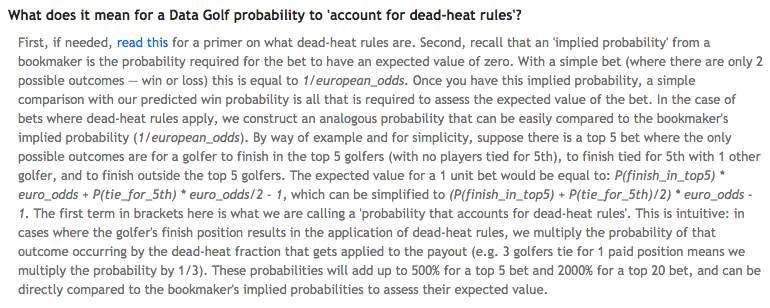Hello all,
I have a general question. The DG implied probability of a golfer finishing the tournament top 20 is listed. However, does this implied probability reflect his odds to finish among the top 20 golfers or place top 20? As you are aware there could be and usually is a group of players tied for 20th place (last week 31 players in the top 20). So take Hovland’s 45.2% implied probability of finishing top 20, is this factoring in the typical 20-26 or so golfers that finish top 20? Thank you.
Dead-heats are accounted for in the pre-tournament odds as that is usually how bookmakers treat the place bets. That is, the top 20 probabilities will add up to 2000%, the top 5 will add up to 500%, etc. Here is a relevant FAQ:
Even though I think most bettors understand this intuitively, once you dig into the details (like most things) there are some intriguing subtleties. For example, we used to simulate tournaments not allowing ties to get probabilities that “account for dead-heats” but this is actually not quite correct (even though the probabilities will add up to the correct values). What you should do is simulate with ties and then apply the relevant tie rules. Dead-heat rules “help” the worse golfer because for the outcomes where they get credited with a half payout (in the case of 2 golfers tied for a single payout spot, e.g. T20) they would be the odd golfer out more than 50% of the time if you weren’t allowing ties. When ties are void, this hurts the worse golfer; this example illustrates:
In the first case, we take the 2.9% tie probability and “give” 0.5% to Bramlett and 2.5% to Simpson (there are some minor rounding issues in that example), which is in proportion to their outright win probabilities. In the second case, for dead-heats, you “give” half of the tie probability to each player which helps Bramlett’s and hurts Simpson’s payout.
For single round sims it matters even more because ties are much more likely! Imagine a simple setup where you are simulating an 18-hole match between 2 golfers with a skill difference of 2 strokes and normally distributed scores. Simulating with no ties (the details of how exactly you do this matter…but here we will just not round the output from the normal distribution) we get a win probability for the worse golfer of 30.4%; simulate with ties and let those ties be void and we get a win probability of 28.7% (this is the correct number – but there is also some further nuance to consider here); and, finally, simulate with ties and apply DH rules we get a probability of 30.8%. The important distinction here is between the first two cases as my guess is that some bettors do simulate their void matchups like this and it can be pretty substantially incorrect. This highlights the importance of actually thinking about the data-generating process: non-integer scores are not possible in golf and so they should not be possible in your simulations either!
Anyways, this is way more information than you likely wanted. I specifically enjoy this stuff because it’s a good example of something that seems simple but actually has a lot going on underneath the hood once you start prodding your understanding of the details!
To return to your question: the bottom line is that our outright odds are what you are looking for if your bookmaker applies dead-heat rules to finish position payouts.
I appreciate the thorough response. Your answer definitely addressed my question. My question, I think was a bit flawed. I’ll try a follow up question. Say a book offered Over/Under top 20 odds on Hovland for the memorial, at the prices of -110 on both sides. According to the DG outright odds, that would equal a 2.4% ((100%-45.2%)-52.4%)) edge on the “not top 20”(over). I decide to place a $110 dollar wager on the over. Considering this book’s rules are such that each of the aforementioned 31 golfers (last week) would be paid out the full $100 on the $110 bet (Not dead Heat). Would the 45.2% top 20 finish implied probability be a what I need to adequately price this prop? Thanks so much for taking time on this.
Ah, I see. No, it sounds like you need the “non-dead-heat” probability, i.e. just the probability of finishing in a position of T20 or better. We really need to get these on the site pre-tournament – currently we only have them on the live model. The dead-heat probability will always be lower: for example, McIlroy’s T20 probability with dead-heats is 35.1% and with full payouts (what you want) it’s 38%. This means that if our models shows an edge with the DH probability, that edge will in reality be quite a bit larger if they are offering full payouts.
I don’t know if anyone on here has an approximate formula for converting between the two probability types (@DanielSong39, perhaps?). Just looking at last week, the sum of the T20 probabilities (no dead-heats) was 22.38. For similar reasons to those mentioned above, you can’t convert between them by just doing T20_DH / (20/22.38).
Ok, thanks again. I really enjoy the content.
I found that T20 (dead-heat) odds were pretty similar to T23 (non dead-heat) odds. Rough conversion below.
T5 (non dead-heat) <-> T6 (dead-heat)
T10 (non dead-heat) <-> T12(dead-heat)
T20 (non dead-heat) <-> T23(dead-heat)
T30 (non dead-heat) <-> T34(dead-heat)
T40 (non dead-heat) <-> T44(dead-heat)
1 Like

